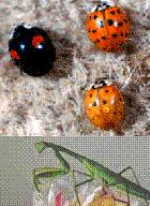Search engine visitors - click here to access entire "$ensible Home" web site
Click here to see a illustration of good bugs and birdhouses.
Dear Jim: I once had a beautiful flower garden but insects are eating it and my kids get lots of bites. I want to avoid using harsh insecticides or electric zappers. What low-cost earth-friendly options are there? - Sue R.

A: Depending on its size, an electrocution-type bug zapper can use from 100 to 200 watts of electricity. Using one just at night from spring through fall can push up your electric costs by $60.
Using a common non-selective zapper can also be counterproductive. There are many beneficial insects that prey on bad insects. The electrocution device does not distinguish between them. Concerning the environment, using extra electricity creates air pollution from the generating plant and contributes to global warming.
You can either buy beneficial insects inexpensively or attract them naturally to your garden. Since most of your children's bug bites are probably from mosquitoes, good insects and animals like dragonflies, bats and toads can make a significant dent in the mosquito population.
A single dragonfly can eat 100 mosquitoes and larvae in 30 minutes. They are attracted by placing three-foot high poles in sunny spots in your yard. They like long pieces of bamboo. Dragonflies do not bite people.
There are special "bug blends" of flower seeds that will attract the good bugs to your yard. A seed pack to handle a 250 sq. ft. area costs about $3.00. Most of the plants are perennials, so you only plant them once.
Praying Mantis is another excellent predator insect to have in your yard. Egg cases cost about $3 each and contain 50 to 200 eggs. These hatch in the spring and the baby mantis start patrolling your garden. It's a great project for your children to watch the eggs and the baby bugs develop.
Toads, from the ground, and bats from the air, eat thousands of mosquitoes per night. To attract toads, break a hole in the side of clay pots and place them upside-down in shady areas.
For $25, you can buy a completed bat house or build your own from scratch. A good bat house has many vertical narrow slots inside with an open bottom. One house can be a home to 20 bats. Various birds are also effective for controlling bugs. Design the birdhouse for the specific species you want.
Instead of expensive and dangerous insecticides to combat tiny pests like aphids and spider mites, consider these good bugs. Green Lacewings (aphid lions) can rid your garden of aphids. One thousand eggs cost only about $6.
The tiny Spider Mite Predator bug will consume 10 adult mites or 20 eggs daily. Beneficial Nematodes ($14 per one million) control fleas and grubs.
Instant Download Update Bulletin No. 540 - list of mail-order suppliers of beneficial insects and organic products, suggestions on attracting and keeping good bugs in your yard, beneficial insect and natural control chart showing beneficial organism and pests it attacks, amounts required and when to release, chart showing products to control over 50 different pests, natural pest control tips, do-it-yourself bird and bat house plans (illustrations with dimensions), suggested dimensions for various birdhouses and nest boxes.
Dear Jim: It gets pleasantly cool some summer evenings and I would like to draw in more air without using noisy fans. Do you have any hints for getting more of this air into the house at night? - Michael L.
A: The only natural method to get extra air flow into your house is to rely on the varying densities of air. Warm air is less dense. In a two-story house, open your second floor window fully.
Open your first floor window slightly less. The warm air moving out the upper windows draws cool air in the first floor. Since these windows are not opened as far, the air velocity is higher creating a cooling breeze.